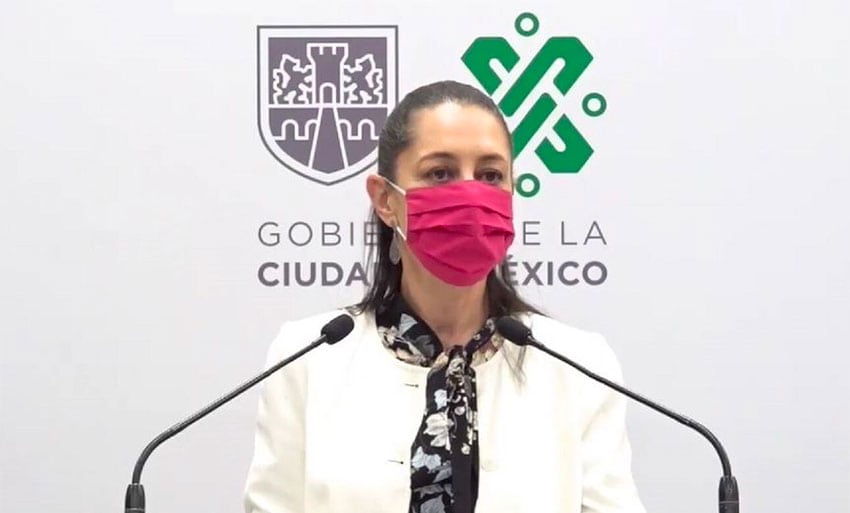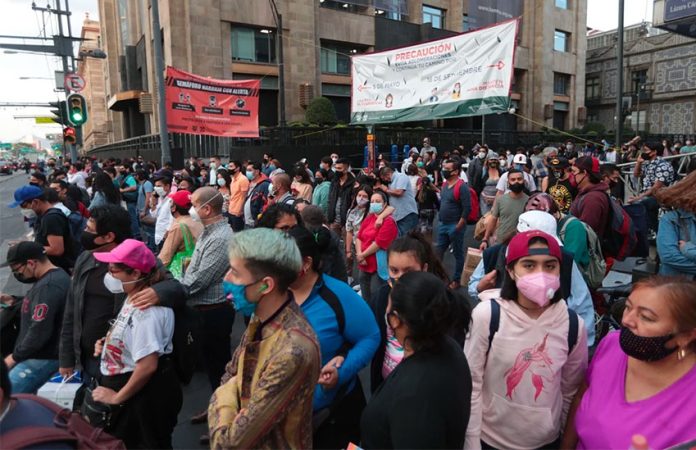After remaining at the red light maximum risk level on the coronavirus stoplight map for eight weeks, Mexico City and Mexico state will switch to high risk orange on Monday as hospital occupancy rates trend downwards in both entities.
Mexico City Mayor Claudia Sheinbaum announced Friday that the capital would transition to a virus control stage she called “orange stoplight without dropping our guard.”
Hospital occupancy in Mexico City has fallen to just below 68%, government official Eduardo Clark told a press conference Friday. The rate had risen to as high as 90% and numerous hospitals in the capital reached 100% capacity in recent weeks.
Clark said that daily case numbers and the positivity rate are also on the wane. Mexico City has recorded more than 514,000 confirmed coronavirus cases since the start of the pandemic and 31,655 Covid-19 deaths, far more in both categories than any other state in the country.
Once the stoplight switches to orange, Mexico City restaurants will be permitted to stay open an additional hour until 10:00 p.m. but they will remain limited to outdoor dining for in-house customers.

Theatrical productions will be permitted in outdoor spaces, and gyms and public swimming pools will be allowed to reopen, although group classes will remain prohibited. Churches and other places of worship will be permitted to reopen between 7:00 a.m and 7:00 p.m. but religious services cannot be held.
Department stores and shopping centers were allowed to reopen this week at 20% of their usual capacity.
Announcing the switch to orange in México state, Governor Alfredo del Mazo noted that new case numbers and hospitalizations have begun to fall. Hospital occupancy for general care beds is 69%, according to federal data, and 58% for beds with ventilators.
Del Mazo said that all commercial establishments that are already open, including department stores and shopping centers, will be permitted to operate at 30% capacity until 9:00 p.m. every day of the week starting Monday. He said that restaurants will be permitted to operate at 30% capacity in indoor spaces and 40% in outdoor areas until 10:00 p.m. seven days a week.
Party halls and nightclubs must remain closed and large events are still prohibited, the governor said.
“We have to be very responsible with the reopening. We have to find the balance that allows us to keep looking after our health, which is the main priority, and at the same time support families’ economies,” del Mazo said.
“… It’s the time to continue being careful and to maintain the preventative measures. [We have to] continue looking after the health of our families, especially the elderly.”
México state ranks second among the 32 states for both coronavirus cases and Covid-19 deaths. It has recorded more than 203,000 of the former and almost 20,000 fatalities.
Including Mexico City and México state, there are currently 13 red light states on the federal stoplight map but the Health Ministry is due to present an updated map Friday night and it appears likely that some additional states will lose their maximum risk status.
Jalisco Governor Enrique Alfaro said Thursday that the risk level in that state had declined to orange light high and asserted that, according to federal government criteria, it was even close to switching to medium risk yellow.
He said that there has been a “significant” reduction in all the indicators the federal government uses to assess the coronavirus risk level, including case numbers and hospitalizations, and claimed that the restrictions implemented by his administration were behind the decrease.
“There is clear evidence that the right thing was done,” Alfaro said.

Coronavirus case numbers are also on the wane nationally compared to January, which was the worst month of the pandemic with almost 440,000 new cases. However, Covid-19 fatalities have increased this month.
The Health Ministry reported an average of 9,482 new cases per day in the first 11 days of February, a 33% decline compared to the January average. The accumulated case tally currently stands at just under 1.97 million.
An average of 1,154 Covid-19 deaths were reported each day between February 1 and Thursday, a 9% increase compared to the daily average last month. The official Covid-19 death toll is 171,234 and the case fatality rate is 8.7, the highest among the 20 countries currently most affected by Covid-19, according to Johns Hopkins University.
Mexico has administered more than 725,000 Pfizer/BioNTech Covid-19 vaccine doses, mainly to health workers, using 95% of all the shots it has received. There were only about 40,000 doses left in the country Thursday night but about 1 million AstraZeneca/Oxford University shots are expected to arrive Sunday and a shipment of almost 500,000 Pfizer doses is slated for delivery on Monday.
The arrival of those two shipments will allow the vaccination of the country’s approximately 15 million seniors to begin. People aged 60 or over who live in large and medium-sized cities have been invited to register for vaccination on a government website.
Source: Milenio (sp), El Universal (sp), Animal Político (sp)
